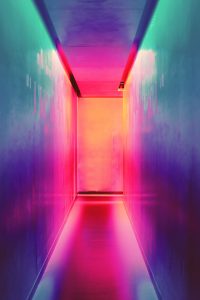Color Power – A Brand’s Secret Weapon
As marketers we know that business is an art of persuasion. While there are many factors that influence shoppers, it is often the subtle and less obvious visual input that generate the most power for your branding campaign. Science has studied and measured the emotional affect that color has on humans and our buying decisions – here are their findings for you to use to your sales advantage.
The Power of Color on People & Marketing
Color has a potent effect on people’s feelings and activities. You can influence your customer’s purchasing behavior and choices, to your benefit, by using the right color in your logo design, branding, and advertising campaigns. I used red in my new 99 logos because it is strong and attention getting.

Scientists Prove that Color Sells
Scientific research has found that 93 percent of customers credit the visual appearance of a product as their primary buying/deciding variable and 85 percent state that the most important reason they bought was due to the color! This is because 80 percent of the visual information that’s communicated by great logo designs are out of the colors used.
- 92% Believe color presents an image of impressive quality
- 90% Feel color can assist in attracting new customers
- 90% Believe customers remember presentations and documents better when color is used
- 83% Believe color makes them appear more successful
- 81% Think color gives them a competitive edge
- 76% Believe that the use of color makes their business appear larger to clientsSource: Conducted by Xerox Corporation and International Communications Research from February 19, 2003 to March 7, 2003, margin of error of +/- 3.1%.
When asked to approximate the importance of color when buying products, 84.7 percent of the total respondents thought that color accounts for more than half among the various factors important for choosing products.
Source: Secretariat of the Seoul International Color Expo
Research reveals people make a subconscious judgment about a person, environment or product within 90 seconds of initial viewing and that between 62% and 90% of that assessment is based on color alone.
Source: CCICOLOR – Institute for Color Research
Color increases brand recognition by up to 80 percent
Source: University of Loyola, Maryland study
Now that you know the the enormous power of color to influence your customers to utilize this business research to construct your own very best new advertising campaigns.
Emotions of Colors for Branding Purposes
Red — Creates a sense of urgency, which can be extremely great for clearance and sales earnings. Fast-food chains, therefore often used to stimulate our desire. Stimulates the full body, heart rate and raising blood pressure, associated with excitement, and movement. Major brands such as Coca Cola, Target, YouTube and Heinz all use red as their primary marketing color.
Blue — The most preferred color of men. It’s linked with peace and success. Over 40% of the INC 5000 fastest growing companies in America use blue in their branding. Blue provides a sense of productivity, curbs appetite, and promotes security. The color used by manufacturers looking to advertise trust, such as banks and brokerage houses. Blue is used in the logos of American Express, LinkedIn, Dell and Facebook.
Green — Associated with health, tranquility, ability, and private character. For relaxing shop surroundings and also to encourage green living and products. Green stimulates and promotes confidence and equilibrium. Green is shown in the logos of Whole Foods, Land Rover and John Deere.
Purple — Ordinarily connected with royalty, wisdom and admiration. Stimulates creative problem solving and imagination. Often used to market beauty and anti-aging products. Yahoo and Hallmark both use purple in their branding.
Orange & Yellow — Cheerful colors that promote optimism and enjoyment. While orange can make sense of caution, yellow is likely to make babies cry. Used to make sense of stress that brings in urge shoppers. Home Depot and Amazon both use orange while Nikon and Ikea use yellow.
Black — Associated with electricity, capability, stability, and endurance. If used in surplus it can get overwhelming.
Grey — Symbolizes feelings of practicality, older age, and solidarity. In excess, it can lead to feelings of depression and nothingness.
White — Associated with feelings of purity, cleanliness and safety. White area in branding layout helps since it could be seen as a clean slate and provoke the imagination.
Colors & Industry
According to this 2017 analysis, Shade in Branding, covering different businesses, these will be the predominant colors utilized in their logos as well as the emotional reaction it generates:
- Restaurants – Red for Care and vitality. Green for well being and health.
- Banking – Blue for dependability. Red for Warmth. Yellow for Cheerfulness
- Apparel and Accessories – Dark for elegance. Red for fire. Orange generates feelings of assurance.
- Automobile and Truck Manufacturers – Grey for caliber. Red for masculinity. Blue for Reliability.
- Home Improvement – Blue for comfort. Orange for Excitement. Red for inspiration.
- Pharmaceuticals – Blue for cleanliness. Orange for optimism. Green for energy.
Color Preferences by Gender
As a company owner, your target clients could be mainly a specific gender. Now you will be able to use certain colors to more efficiently market to such individuals.
According to this revolutionary color study from Joe Hallock, here are the findings by sex of color preferences:
Men’s Best Favorite Colors
Blue – 57 percent
Green – 14 percent
Black 9 percent
Red – 7 percent
Orange – 5 percent
Grey – 3 percent
Brown – two percent
White – two percent
Women’s Best Favorite Colors
Blue – 35 percent
Purple – 23 percent
Green -14 percent
Red – 9 percent
Black – 6 percent
Orange – 5 percent
Brown – 3 percent
Yellow – 3 percent
Men and Women’s Least Favorite Colors
Brown – 20-27 percent
Orange – 22 -33 percent
Color Shades Preference by Gender
Unsurprisingly, studies have decided that men favor bolder tones and women like softer, paler colors. Thus men’s manufacturers have enhanced their brand awareness with darker colors and feminine concentrated products do nicely with lighter tints of colors as brand colors.
Conclusion and Action Steps
Use these proven effects of color to your benefit by integrating them in your marketing and attract your target clients. The right colors will provide the feelings you want your products to evoke.
Review your logo, site design and advertising materials to establish whether you’re positively or negatively utilizing color to interest your clients.
References: Studies about Color for Branding
https://www.ncbi.nlm.nih.gov/pubmed/2235253
http://www.joehallock.com/edu/COM498/preferences.html
http://faculty.haas.berkeley.edu/c_lee/manuscript.pdf
About the Author:
 Marsha Kelly sold her first business for more than a million dollars. She has shared hard-won experiences as a successful serial entrepreneur on her blog Best 4 Businesses http://best4businesses.com. Marsha also regularly shares business tips, ideas, and suggestions as well as product reviews for business readers. As a serial entrepreneur who has done “time” in corporate America, Marsha has learned what products and services really work well in business today. You can learn from her experiences from shopping the internet for tools, supplies, and information to build your businesses and improve lives financially.
Marsha Kelly sold her first business for more than a million dollars. She has shared hard-won experiences as a successful serial entrepreneur on her blog Best 4 Businesses http://best4businesses.com. Marsha also regularly shares business tips, ideas, and suggestions as well as product reviews for business readers. As a serial entrepreneur who has done “time” in corporate America, Marsha has learned what products and services really work well in business today. You can learn from her experiences from shopping the internet for tools, supplies, and information to build your businesses and improve lives financially.
